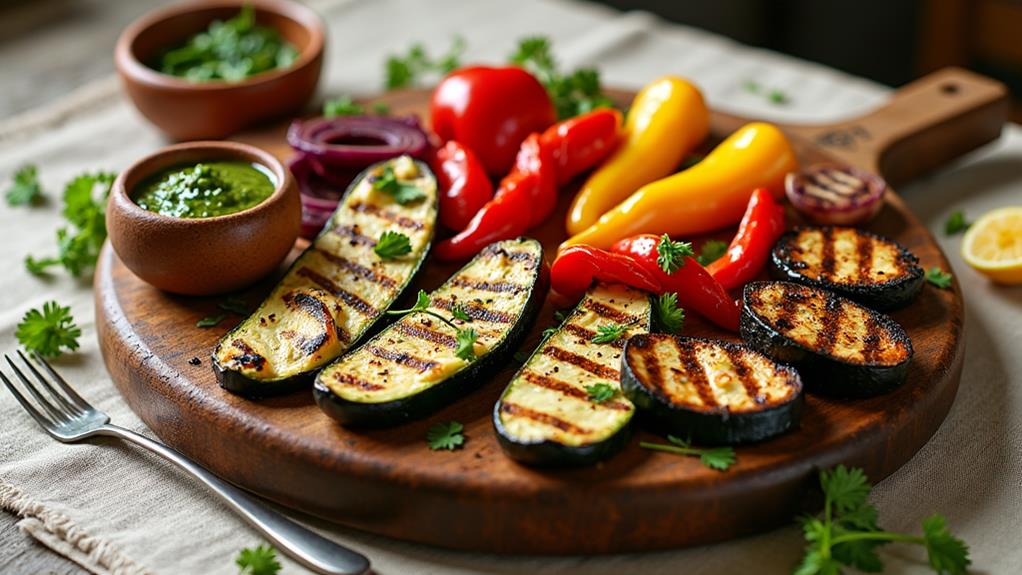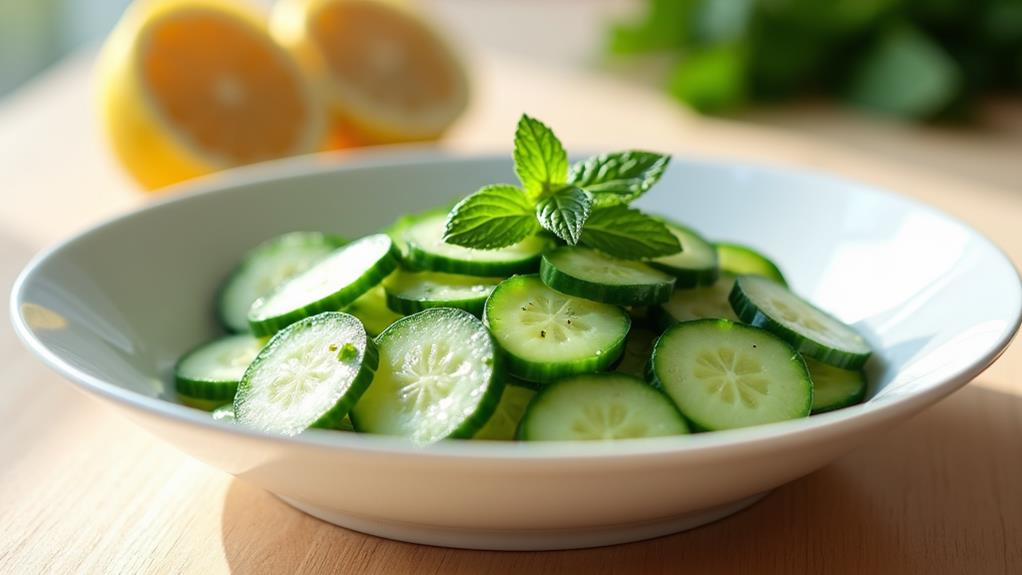You've likely encountered grilled vegetables before, but have you experienced them paired with the vibrant flavors of chimichurri? This Argentine sauce transforms a simple vegetable platter into a culinary adventure. As you explore this dish, you'll discover how the smoky char of grilled zucchini, peppers, and eggplant harmonizes with the tangy, herbaceous notes of chimichurri. It's not just a side dish; it's a celebration of summer's bounty that can easily take center stage at your next gathering. But there's more to this colorful platter than meets the eye—its history and versatility might surprise you.
Key Takeaways
- Grill a variety of vegetables like zucchini, peppers, and eggplant until charred and tender, about 3-5 minutes per side.
- Prepare chimichurri sauce by combining chopped parsley, minced garlic, red wine vinegar, and olive oil.
- Arrange grilled vegetables on a large platter, grouping similar colors and shapes for visual appeal.
- Drizzle chimichurri sauce over the vegetables and serve additional sauce on the side.
- Serve warm or at room temperature as a versatile side dish or vegetarian main course.
History
Grilled vegetable platters have a rich history dating back centuries. You'll find that the practice of grilling vegetables originated in ancient civilizations, where people discovered that cooking over an open flame enhanced the flavors of their produce. As agriculture developed and diversified, so did the variety of vegetables used in these dishes.
In Mediterranean cultures, you'll see that grilled vegetable platters became a staple, often served as part of mezze or antipasti. The combination of charred vegetables with herbs and olive oil has been a favorite for generations.
Over time, this culinary tradition spread across the globe, adapting to local ingredients and tastes. The addition of chimichurri sauce to grilled vegetables is a more recent innovation, originating in Argentina. You'll notice that this tangy, herb-based sauce complements the smoky flavors of grilled vegetables perfectly.
As global cuisine continues to evolve, you'll find that grilled vegetable platters have become a popular choice for health-conscious diners and those seeking plant-based options. Today, you can enjoy this versatile dish in various settings, from casual backyard barbecues to upscale restaurants.
Recipe
Grilled vegetable platters are a delicious and healthy option for summer gatherings or as a colorful side dish for any meal. This recipe combines a variety of fresh vegetables with a zesty chimichurri sauce, creating a perfect balance of flavors and textures.
By using just five key ingredients, this dish focuses on the natural sweetness of grilled vegetables enhanced by the herbaceous kick of chimichurri. The result is a simple yet impressive platter that's sure to please both vegetarians and meat-eaters alike.
- Mixed vegetables (such as zucchini, bell peppers, eggplant, and red onion): 4 cups (1 liter)
- Olive oil: 1/4 cup (60 ml)
- Fresh parsley: 1 cup (60 g)
- Garlic cloves: 2
- Red wine vinegar: 2 tablespoons (30 ml)
Preheat your grill to medium-high heat. Slice the vegetables into thick pieces and brush them with olive oil. Grill the vegetables for 3-5 minutes per side until they've nice char marks and are tender.
While the vegetables are grilling, make the chimichurri sauce by finely chopping the parsley and garlic, then mixing them with the remaining olive oil and red wine vinegar. Once the vegetables are done, arrange them on a platter and drizzle with the chimichurri sauce.
For best results, choose vegetables that are in season and at their peak ripeness. Don't overcrowd the grill to ensure even cooking.
The chimichurri sauce can be made ahead of time and stored in the refrigerator for up to 2 days, allowing the flavors to meld together. Experiment with different vegetable combinations to suit your taste preferences, and serve the platter warm or at room temperature for maximum flavor enjoyment.
Cooking Steps
To create your grilled vegetable platter, you'll start by preheating your grill to medium-high heat and preparing your vegetables.
Next, you'll slice the veggies into thick pieces, brush them with olive oil, and grill them for 3-5 minutes per side until they're tender and have beautiful char marks.
While the vegetables are cooking, you'll whip up the chimichurri sauce by finely chopping parsley and garlic, then mixing them with olive oil and red wine vinegar before arranging the grilled vegetables on a platter and drizzling them with the flavorful sauce.
Step 1. Preheat Grill to Medium-High
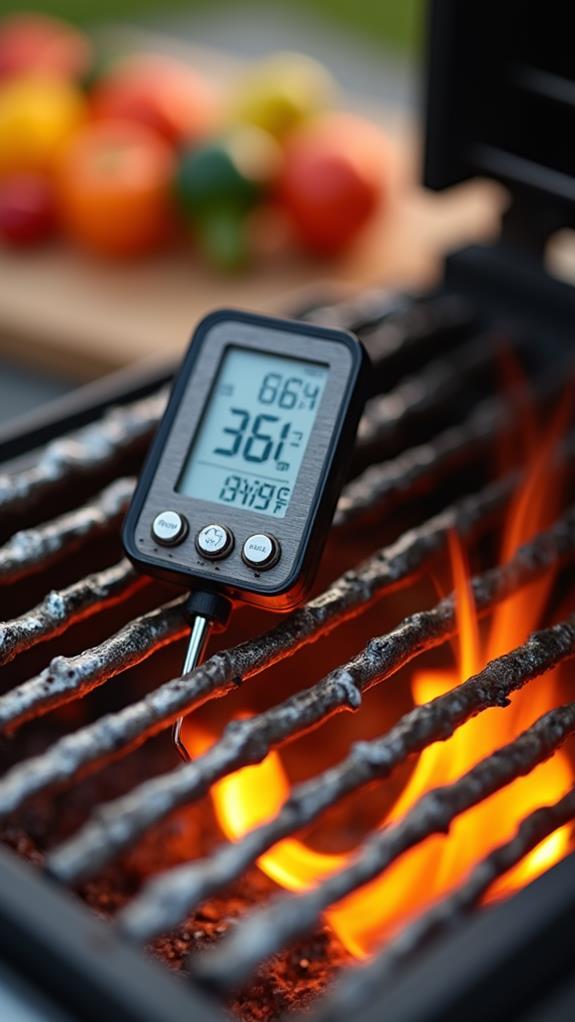
The sizzling symphony of a perfectly preheated grill sets the stage for your vegetable masterpiece. To achieve this, you'll want to preheat your grill to medium-high heat, which typically ranges between 375°F and 450°F (190°C to 230°C). This temperature range ensures that your vegetables will cook evenly and develop those coveted char marks without burning.
Start by turning on all burners if you're using a gas grill, or arranging your charcoal if you're using a charcoal grill.
Close the lid and let the grill heat up for about 10-15 minutes. This preheating time is crucial, as it allows the grates to get hot enough to sear the vegetables properly.
While you're waiting, you can prepare your vegetables by slicing them and brushing them with olive oil.
To check if your grill is ready, hold your hand about 4 inches above the grates. If you can only keep it there for 3-4 seconds before it feels too hot, you've reached the ideal medium-high heat.
Step 2. Slice and Oil Vegetables
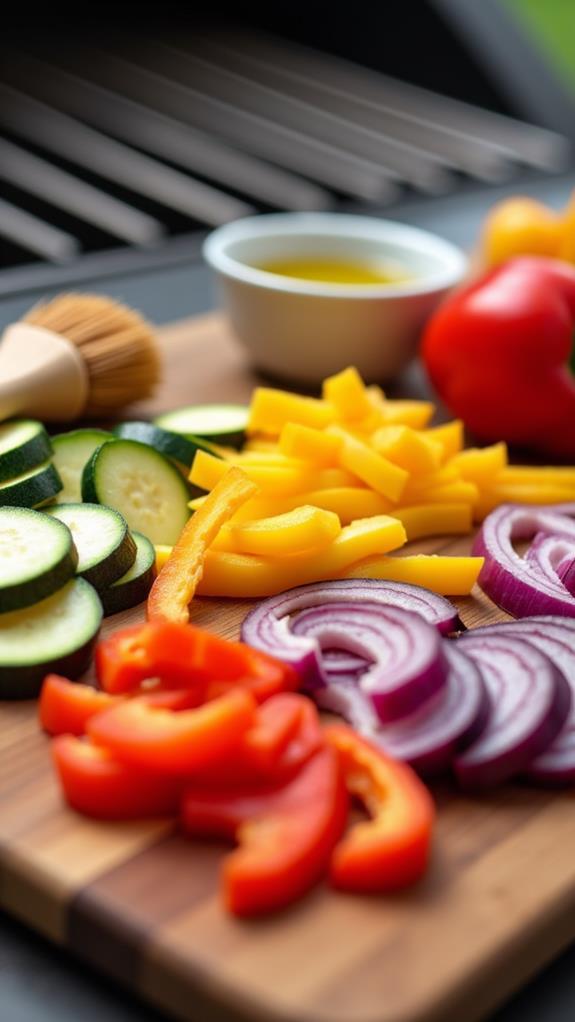
With your grill preheating, it's time to prepare your vegetables for their sizzling transformation.
Begin by selecting a variety of colorful veggies, such as zucchini, bell peppers, eggplant, and red onion. Wash them thoroughly and pat them dry with a clean kitchen towel. Using a sharp knife, slice the vegetables into thick pieces, about 1/2 to 3/4 inch wide. This size ensures they'll hold up well on the grill while absorbing plenty of smoky flavor.
Next, arrange the sliced vegetables on a large baking sheet or cutting board. Drizzle them generously with olive oil, making sure each piece is evenly coated. This will prevent sticking and promote those beautiful char marks you're after.
Don't forget to season your veggies with salt and pepper to enhance their natural flavors. For an extra kick, you can add dried herbs like oregano or thyme.
Once you've oiled and seasoned your vegetables, they're ready for the grill. Remember, different vegetables may require varying cooking times, so be prepared to add them to the grill in stages for optimal results.
Step 3. Grill Vegetables 3-5 Minutes

Once your grill is hot and ready, it's time to start cooking those perfectly prepared vegetables. Place your oiled vegetable slices on the grill, ensuring they're not overcrowded. You'll want to give each piece enough space to cook evenly and develop those beautiful grill marks.
Grill the vegetables for about 3-5 minutes on each side. The exact time will depend on the thickness of your slices and the heat of your grill. Keep a close eye on them, as you don't want them to burn.
You're looking for a nice char on the outside while maintaining a tender, but not mushy, interior. Use tongs to flip the vegetables halfway through cooking. You'll know they're done when they've distinct grill marks and are easily pierced with a fork.
Remember, different vegetables may cook at slightly different rates. Denser vegetables like eggplant might need a bit more time, while zucchini and bell peppers tend to cook faster.
As each vegetable finishes cooking, transfer it to a clean platter. This will prevent overcooking and allow you to arrange your platter as you go.
Step 4. Make Chimichurri Sauce

While your vegetables are grilling, it's time to whip up the vibrant chimichurri sauce. Start by finely chopping the fresh parsley, making sure to include both the leaves and tender stems for maximum flavor.
Next, mince the garlic cloves until they're almost paste-like, which will ensure even distribution throughout the sauce. In a medium bowl, combine the chopped parsley and minced garlic, then add the remaining olive oil and red wine vinegar. Mix these ingredients thoroughly, allowing the flavors to meld together.
For a smoother consistency, you can use a food processor or blender to pulse the ingredients briefly. However, be careful not to over-process, as you want to maintain some texture in the sauce.
Taste the chimichurri and adjust the seasoning if needed, adding a pinch of salt or an extra splash of vinegar for brightness. If you prefer a spicier sauce, you can incorporate a small amount of crushed red pepper flakes.
Once you're satisfied with the flavor, set the chimichurri aside until your grilled vegetables are ready to be plated and served.
Step 5. Arrange and Drizzle Platter
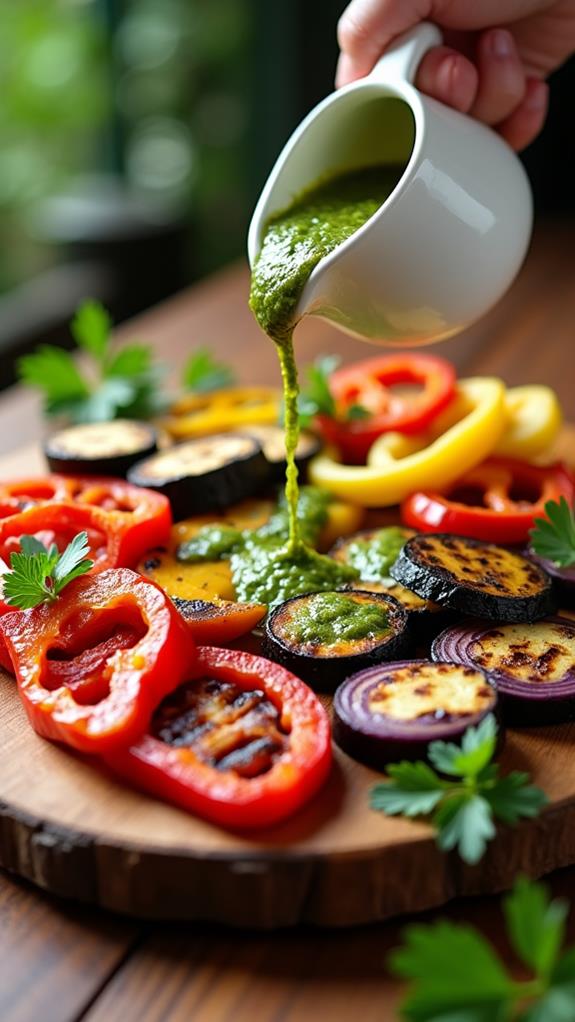
The final step in creating your grilled vegetable platter is arranging and drizzling. Once your vegetables are perfectly grilled and your chimichurri sauce is ready, it's time to bring everything together.
Start by selecting a large, clean platter that will comfortably accommodate all your grilled vegetables. Arrange the vegetables in an appealing manner, grouping similar colors and shapes together for visual interest. You can create a pattern or simply spread them out evenly across the platter.
Next, take your freshly prepared chimichurri sauce and drizzle it generously over the arranged vegetables. Use a spoon or a small pitcher for more control over the distribution. Don't be shy with the sauce; it's meant to coat the vegetables and infuse them with its zesty flavor.
Make sure to cover all areas of the platter, ensuring that each vegetable gets a fair share of the sauce. If you prefer, you can also serve additional chimichurri on the side for guests who might want extra.
Your grilled vegetable platter is now ready to be served and enjoyed!
Final Thoughts
Versatility shines through in this grilled vegetable platter recipe. You'll find it's easy to adapt to your preferences and what's available seasonally. Don't hesitate to experiment with different vegetables, like asparagus, mushrooms, or even sliced sweet potatoes. The key is to choose vegetables that grill well and complement each other in flavor and texture.
Remember, the chimichurri sauce is more than just a topping; it's an integral part of the dish that brings everything together. You can adjust its intensity by adding more or less garlic, or even include some red pepper flakes for extra heat.
If you're short on time, you can prepare the sauce a day or two in advance, allowing the flavors to meld beautifully.
This dish isn't just for summer barbecues; it's a fantastic year-round option for healthy eating. You can serve it as a side dish, a vegetarian main course, or even as a colorful addition to your holiday table.
With its vibrant colors and enticing aroma, this grilled vegetable platter is sure to impress your guests and satisfy your taste buds.

